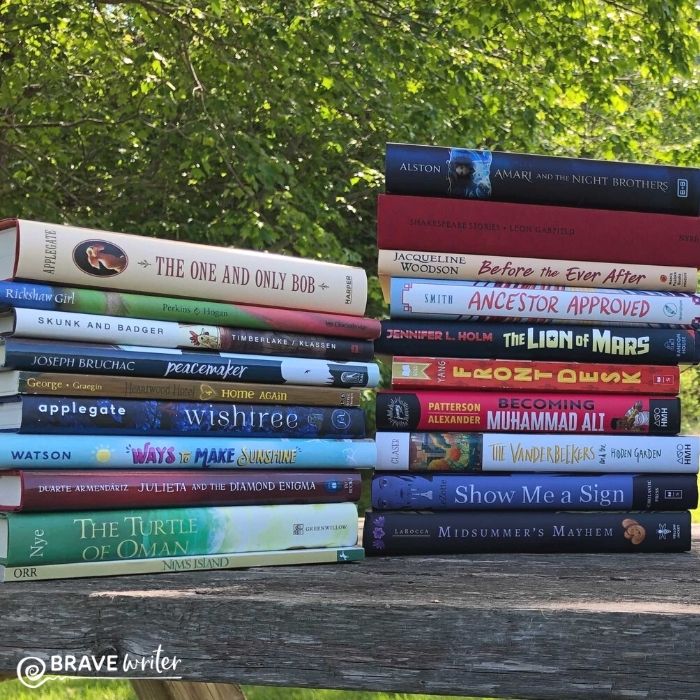Illustrations: 2021-2022 Darts & Arrows

A Brave Writer parent asked: which 2021-2022 Dart and Arrow books have fantastic illustrations that enhance the story?
Let’s break down the illustrated content book by book!
Dart
August: The One and Only Bob by Katherine Applegate
This book has some illustrations. They add character development with visuals, yes, but they are not make or break for understanding the events in the book.
September: Rickshaw Girl by Mitali Perkins
Art is a key aspect of the storyline and is displayed throughout the story, so a physical copy of the book is recommended. By the way, this book is being made into a movie! So exciting!
October: Skunk and Badger by Amy Timberlake
If you purchase one physical copy of a Dart book, make it this one. The illustrations are delightful and add to the storytelling in such touching ways that I would not want families to miss out.
November: Peacemaker by Joseph Bruchac
There are no illustrations, but there is a map of The Land of the Five Nations in the front matter of the book.
December: Heartwood Hotel: A True Home by Kallie George
Much like Skunk and Badger, this is one to consider purchasing for the sweet illustrations.
January: Wishtree by Katherine Applegate
Sketches of leaves and animals populate the pages, which is lovely, but there are only a handful of illustrations that are poignant to the story and add depth to scenes throughout. If you can acquire a physical copy, that would be great, but it will not significantly impact the story to listen to it on audiobook.
February: Ways to Make Sunshine by Renée Watson
Sweet illustrations are sprinkled throughout the book. They are not vital to the storyline, but the ones related to Ryan and her hair can help kids visualize the situations she finds herself in.
March: Julieta and the Diamond Enigma by Luisana Duarte Armendáriz
There are illustrations at the beginning of each chapter, but they are not essential to the story.
April: The Turtle of Oman by Naomi Shihab Nye
The front matter contains a basic map showing a dotted arrow connecting Oman and Detroit. There are small but detailed sketches at the beginning of each chapter and the lists Aref makes in his journals are represented in a handwriting font. None of these features are vital to the story, but they add sweet notes of visual interest.
May: Nim’s Island by Wendy Orr
This book has simple line drawings throughout and the email correspondence is represented in a different font. While engaging, these visual features are not required to understand the story.
Arrow
August: Amari and the Night Brothers by B. B. Alston
Each chapter kicks off with a small illustration and text messages and other correspondences are represented in different fonts throughout the book. None of those features are vital to the following storyline.
September: Leon Garfield’s Shakespeare Stories by Leon Garfield
Black and white watercolor-style paintings are scattered throughout the text, but they are not essential to understanding the stories.
October: Before the Ever After by Jacqueline Woodson
There are no illustrations in this text. The visual appeal of this novel in verse is the layout of the poetry on the page.
November: Ancestor Approved: Intertribal Stories for Kids edited by Cynthia Leitich Smith
There are no illustrations in this text, but the cover art is gorgeous.
December: The Lion of Mars by Jennifer L. Holm
This book has no illustrations but correspondence is represented in a different font. The author’s note has three photos from Jennifer Holm’s life and research.
January: Front Desk by Kelly Yang
The cover is delightful, but there are no illustrations inside the book. The author’s note has two photos of KellyYang as a young child.
February: Becoming Muhammad Ali by James Patterson and Kwame Alexander
While the full-page illustrations in this book are not vital, they add to the setting and character development. The other visual feature that adds depth to this book is the contrasting format of poetry used for Cassius’s first-person perspective and prose employed when the storytelling switches over to his best friend Lucky. It’s a genius story structure that is impactful on the page.
March: The Vanderbeekers and the Hidden Garden by Karina Yan Glaser
A map of Harlem and South Bronx—with all of the key locations for the story map out—can be found on the front inside cover. The illustrations within the pages include garden plans, receipts, lists, and signs. While not essential, they add to the storytelling, and since all of the illustrations were created by Karina Yan Glaser herself, they may inspire young writers to add simple illustrations to their own stories.
April: Show Me a Sign by Ann Clare LeZotte
This book contains no illustrations. At the back of the book, there is a wonderful note about the languages represented in the book, so don’t miss that!
May: Midsummer’s Mayhem by Rajani LaRocca
There are about a dozen illustrations in this book, a few are full-page spreads, but they are not necessary to understand the events unfolding in the story. Song lyrics, poems, and posters are represented in different fonts. There are recipes at the back of the book.
That’s it! So much goodness!


















